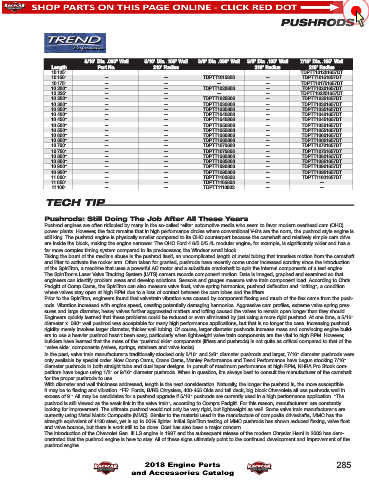Page 286 - 2018 Racecar Engineering Engine Parts and Accessories Catalog
P. 286
PUSHRODS
5/16" Dia. .080" Wall 5/16" Dia. .105" Wall 3/8" Dia. .080" Wall 3/8" Dia. .135" Wall 7/16" Dia. .165" Wall
Length Part No. 210° Radius 210° Radius 210° Radius
10.125" TDPTT101251657DT
10.150" — — TDPTT1015803 — TDPTT10151657DT
10.175" — — — — TDPTT101751657DT
10.200" — — TDPTT1020803 — TDPTT10201657DT
10.225" — — — — TDPTT102251657DT
10.250" — — TDPTT1025803 — TDPTT10251657DT
10.300" — — TDPTT1030803 — TDPTT10301657DT
10.350" — — TDPTT1035803 — TDPTT10351657DT
10.400" — — TDPTT1040803 — TDPTT10401657DT
10.450" — — TDPTT1045803 — TDPTT10451657DT
10.500" — — TDPTT1050803 — TDPTT10501657DT
10.550" — — TDPTT1055803 — TDPTT10551657DT
10.600" — — TDPTT1060803 — TDPTT10601657DT
10.650" — — TDPTT1065803 — TDPTT10651657DT
10.700" — — TDPTT1070803 — TDPTT10701657DT
10.750" — — TDPTT1075803 — TDPTT10751657DT
10.800" — — TDPTT1080803 — TDPTT10801657DT
10.850" — — TDPTT1085803 — TDPTT10851657DT
10.900" — — TDPTT1090803 — TDPTT10901657DT
10.950" — — TDPTT1095803 — TDPTT10951657DT
11.000" — — TDPTT1100803 — TDPTT11001657DT
11.050" — — TDPTT1105803 — —
11.100" — — TDPTT1110803 — —
TECH TIP
Pushrods: Still Doing The Job After All These Years
Pushrod engines are often ridiculed by many in the so-called "elite" automotive media who seem to favor modern overhead cam (OHC)
power plants. However, the fact remains that in high performance circles where conventional V-8's are the norm, the pushrod style engine is
still king. The pushrod engine is physically smaller compared to its OHC counterpart because the camshaft and relatively simple cam drive
are inside the block, making the engine narrower. The OHC Ford 4.6/5.0/5.4L modular engine, for example, is significantly wider and has a
far more complex timing system compared to its predecessor, the Windsor small block.
Taking the brunt of the media's abuse is the pushrod itself, an uncomplicated length of metal tubing that transfers motion from the camshaft
and lifter to activate the rocker arm. Often taken for granted, pushrods have recently come under increased scrutiny since the introduction
of the SpinTron, a machine that uses a powerful AC motor and a substitute crankshaft to spin the internal components of a test engine.
The SpinTron's Laser Valve Tracking System (LVTS) camera records component motion. Data is imaged, graphed and examined so that
engineers can identify problem areas and develop solutions. Sensors and gauges measure valve train component load. According to Chris
Padgitt of Comp Cams, the SpinTron can also measure valve float, valve spring harmonics, pushrod deflection and "lofting", a condition
where valves stay open at high RPM due to a loss of contact between the cam lobes and the lifters.
Prior to the SpinTron, engineers found that valvetrain vibration was caused by component flexing and much of the flex came from the push-
rods. Vibration increased with engine speed, creating potentially damaging harmonics. Aggressive cam profiles, extreme valve spring pres-
sures and large diameter, heavy valves further aggravated matters and lofting caused the valves to remain open longer than they should.
Engineers quickly learned that these problems could be reduced or even eliminated by just using a more rigid pushrod. At one time, a 5/16"
diameter x .080" wall pushrod was acceptable for many high performance applications, but that is no longer the case. Increasing pushrod
rigidity merely involves larger diameter, thicker wall tubing. Of course, larger diameter pushrods increase mass and convincing engine build-
ers to use a heavier pushrod hasn't been easy, particularly when lightweight valve train components are the vital to high RPM. However,
builders have learned that the mass of the "pushrod side" components (lifters and pushrods) is not quite as critical compared to that of the
"valve side" components (valves, springs, retainers and valve locks).
In the past, valve train manufacturer's traditionally stocked only 5/16" and 3/8" diameter pushrods and larger, 7/16" diameter pushrods were
only available by special order. Now Comp Cams, Crane Cams, Manley Performance and Trend Performance have begun stocking 7/16"
diameter pushrods in both straight tube and dual taper designs. In pursuit of maximum performance at high RPM, NHRA Pro Stock com-
petitors have begun using 1/2" or 9/16" diameter pushrods. When in question, it's always best to consult the manufacturer of the camshaft
for the proper pushrods to use.
With diameter and wall thickness addressed, length is the next consideration. Naturally, the longer the pushrod is, the more susceptible
it may be to flexing and vibration. "FE" Fords, B/RB Chryslers, 400-455 Olds and tall deck, big block Chevrolets all use pushrods well in
excess of 9." All may be candidates for a pushrod upgrade if 5/16" pushrods are currently used in a high performance application. "The
pushrod is still viewed as the weak link in the valve train", according to Comp's Padgitt. For this reason, manufacturers' are constantly
looking for improvement. The ultimate pushrod would not only be very rigid, but lightweight as well. Some valve train manufacturer's are
currently using Metal Matrix Composite (MMC). Similar to the material used in the manufacture of composite driveshafts, MMC has the
strength equivalent of 4130 steel, yet is up to 60% lighter. Initial SpinTron testing of MMC pushrods has shown reduced flexing, valve float
and valve bounce, but there is work still to be done. Cost has also been a major concern.
The introduction of the Chevrolet Gen. III LS engine in 1997 and the subsequent release of the modern Chrysler Hemi in 2003 has dem-
onstrated that the pushrod engine is here to stay. All of these signs ultimately point to the continued development and improvement of the
pushrod engine.
2018 ENGINE BUILDER CATALOG 285

